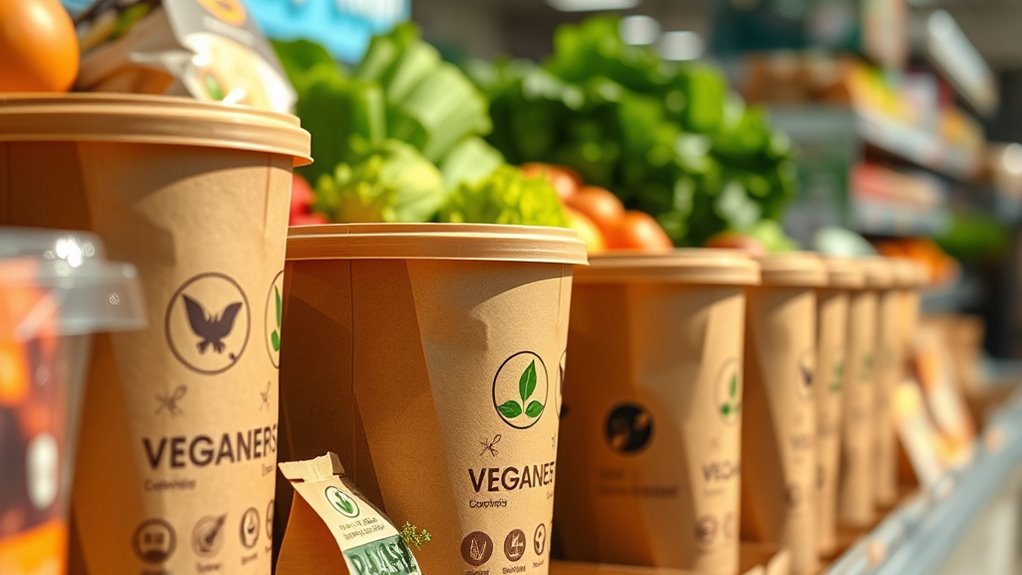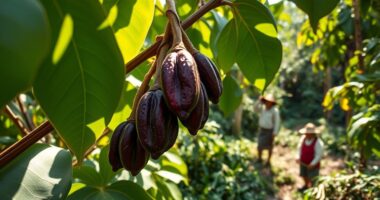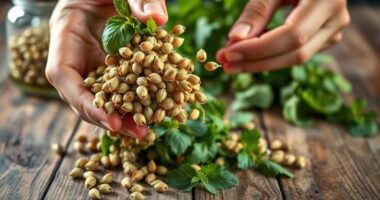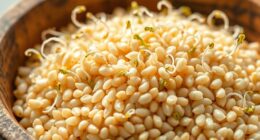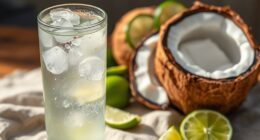By 2025, you’ll notice eco-friendly packaging in grocery aisles that’s biodegradable, reusable, and even edible. Expect containers made from plant-based materials, vibrant natural dyes, and innovative inks derived from sustainable sources. Smart packages with sensors will help reduce waste by tracking freshness. These changes aim to cut plastic pollution, promote circular use, and support sustainability efforts. Keep exploring to discover more about the future of vegan packaging and how it benefits your shopping experience.
Key Takeaways
- Biodegradable, plant-based, and edible packaging options will reduce plastic waste and environmental impact.
- Natural dyes and plant-based inks will replace harmful chemicals, offering vibrant, eco-friendly packaging.
- Reusable, modular, and smart packaging with sensors will enhance sustainability and reduce food waste.
- Packaging innovations will focus on eliminating single-use plastics and supporting zero-waste shopping experiences.
- Sustainable production methods will incorporate renewable materials and energy-efficient manufacturing processes.
Biodegradable Packaging Materials Transforming Waste Management
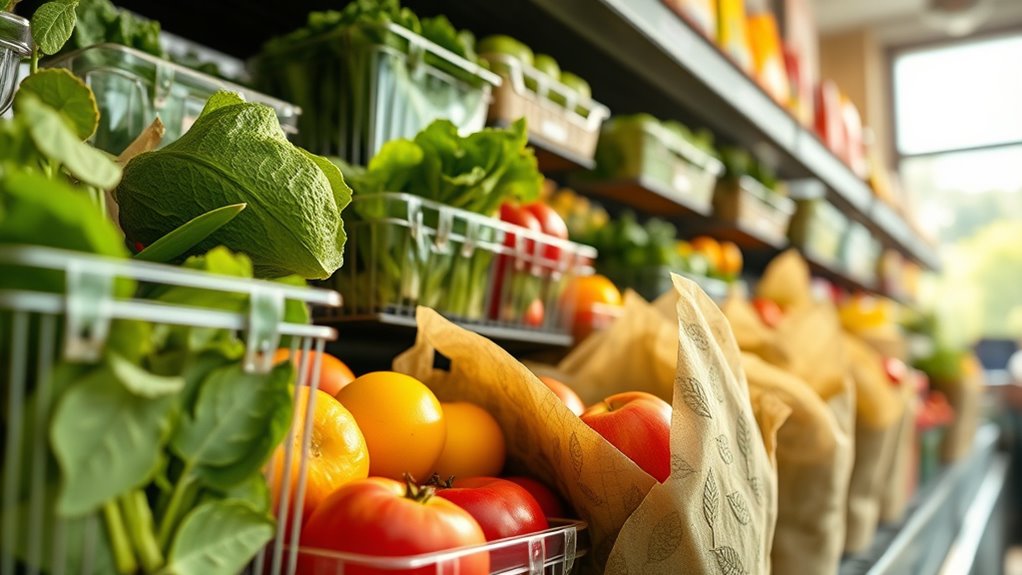
As biodegradable packaging materials become more advanced, they are revolutionizing waste management by offering sustainable alternatives to traditional plastics. Biodegradable plastics break down naturally, reducing landfill accumulation and pollution. These materials are often made from renewable resources, making them environmentally friendly options for packaging. Compostable materials go a step further, transforming into nutrient-rich compost when properly disposed of, which benefits soil health. By choosing biodegradable plastics and compostable materials, you help decrease reliance on fossil fuels and lower greenhouse gas emissions. This shift not only reduces waste but also encourages more eco-conscious packaging practices. As innovation continues, these materials will become even more effective, making waste management more sustainable and less harmful to the planet. Understanding seed consumption risks is also important for reducing environmental impact, as responsible disposal of seed-based products can further enhance sustainability efforts. Additionally, advancements in biodegradable packaging are helping to address concerns about plastic pollution in oceans and wildlife habitats.
Plant-Based Containers Redefining Food Storage
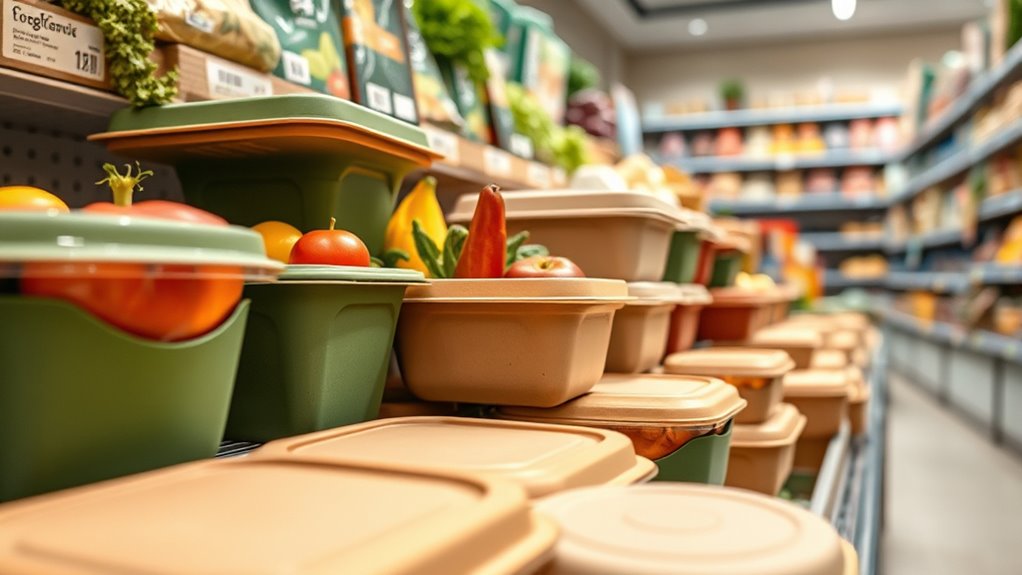
Building on the advancements in biodegradable packaging, plant-based containers are emerging as a groundbreaking solution for food storage. These containers are crafted from biodegradable plastics derived from renewable plant sources, making them eco-friendly alternatives to traditional plastics. With sustainable sourcing at their core, they reduce reliance on fossil fuels and lower environmental impact. These containers are durable, lightweight, and designed to keep food fresh longer, helping you reduce waste. They also align with eco-conscious consumer values, encouraging more sustainable shopping habits. As grocery stores adopt these plant-based options, you’ll notice a shift toward packaging that not only protects your food but also supports environmental health. This innovation bridges practicality with sustainability, redefining how food storage can be both effective and eco-friendly.
Edible Packaging: A Delicious Solution for Waste Reduction
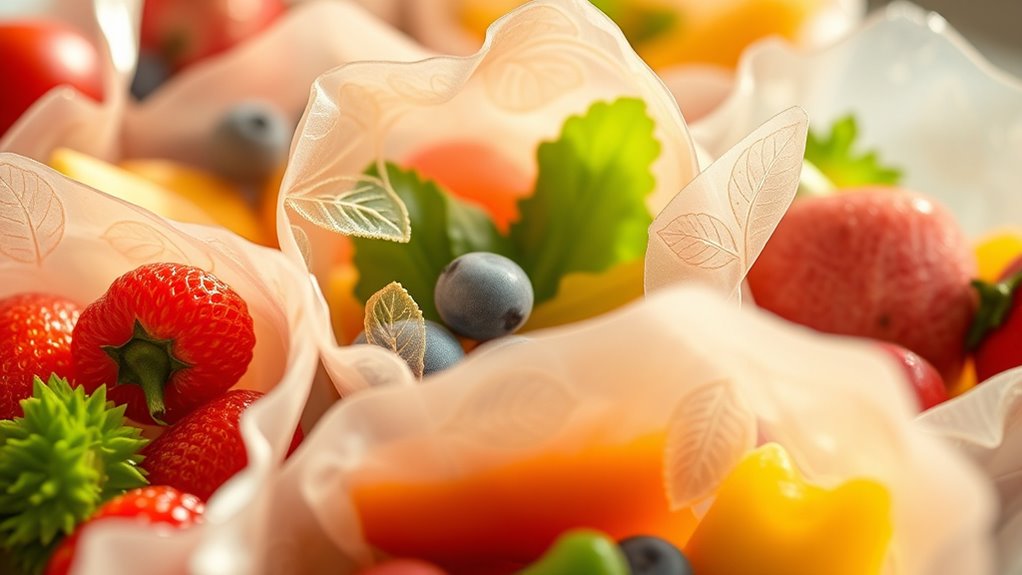
Imagine enjoying your snack wrapped in a tasty, eco-friendly edible container that reduces plastic waste. These innovative food designs not only satisfy your taste buds but also help protect the environment. As edible packaging evolves, it offers a delicious way to make waste reduction a seamless part of your daily life. Incorporating color accuracy into product branding could also enhance consumer connection and brand loyalty.
Tasty, Eco-Friendly Materials
Edible packaging offers a compelling solution to reduce waste by transforming leftover materials into tasty, biodegradable wrappers. These innovative materials are made through sustainable farming practices, ensuring they’re eco-friendly from the start. By utilizing ingredients like seaweed, grains, or starches, companies can create packaging that’s both delicious and biodegradable. This approach also supports the shift toward renewable energy, as manufacturing processes become more energy-efficient and less dependent on fossil fuels. Additionally, the development of balance and coordination development in young children can be supported through engaging packaging designs that encourage interaction. Introducing sustainable materials into packaging not only cuts down on plastic waste but also appeals to consumers seeking environmentally conscious options. As technology advances, expect to see more of these edible wrappers in your grocery aisle, making waste reduction seamless and enjoyable. You’ll soon have delicious, planet-friendly packaging at your fingertips.
Reducing Plastic Waste
As consumers become more aware of environmental impacts, reducing plastic waste has gained urgent importance. Plastic pollution clogs oceans, harms wildlife, and overwhelms recycling systems. Traditional recycling faces challenges like contamination and limited processing capabilities, making it difficult to manage plastic waste effectively. Edible packaging offers a promising solution by eliminating the need for disposal altogether. Instead of contributing to recycling challenges, you can enjoy packaging that’s safe to eat and biodegradable. These innovations reduce reliance on single-use plastics and help curb plastic pollution at its source. By adopting edible packaging, you’re actively supporting waste reduction efforts, lowering landfill overflow, and promoting a more sustainable future. This delicious alternative can transform how you think about packaging, turning waste into an edible experience. Incorporating natural materials into packaging design further enhances its sustainability and appeal, especially when considering spoiled lemon juice and its impact on food safety. Additionally, emphasizing recyclability and biodegradability can help consumers make more eco-conscious choices and further reduce environmental footprints.
Innovative Food Designs
Innovative food designs are transforming the way we think about packaging by seamlessly integrating functionality with sustainability. Edible packaging offers a delicious, waste-reducing alternative to traditional materials, turning your food into its own container. Imagine wrapping a snack in sustainable food wrapping that’s both biodegradable and tasty. You’ll also see recyclable utensils that can be eaten after use or composted easily, reducing single-use waste. These innovations promote zero waste while enhancing convenience. For example, edible cups made from natural ingredients eliminate the need for disposable cups, and flavored edible wrappers keep food fresh without synthetic preservatives. As these designs become mainstream, you’ll enjoy a more eco-friendly shopping experience that aligns with your sustainability goals. This shift makes waste reduction a delicious and practical part of everyday life. Incorporating eco-friendly packaging options further supports environmental conservation efforts and encourages sustainable consumer habits.
Innovative Ink and Dyes From Natural Sources
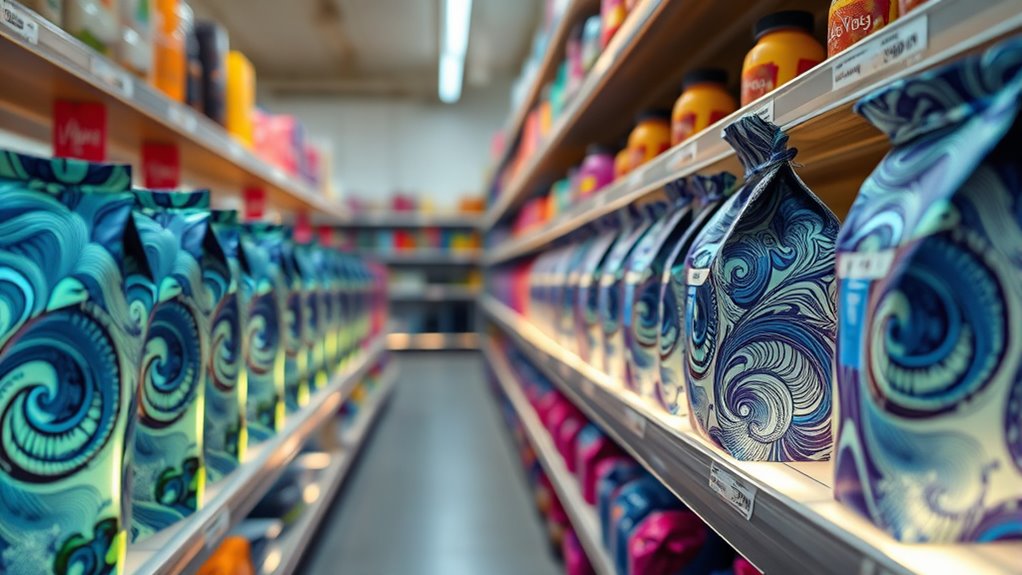
You can now explore how plant-based dyes offer vibrant, sustainable options for packaging. Eco-friendly ink formulations are advancing to diminish environmental impact without sacrificing quality. Additionally, new color stability methods ensure these natural inks remain consistent over time, making them a practical choice for brands aiming for eco-conscious innovation. Incorporating natural dye sources and mindful decluttering strategies into production can also help companies reduce waste and promote sustainability throughout their supply chain. Emphasizing active listening and transparency in communication can further enhance brand trust and consumer loyalty. As the demand for sustainable packaging continues to grow, innovation in natural inks will play a crucial role in meeting consumer expectations.
Plant-Based Dye Sources
Plant-based dye sources are transforming how we approach sustainable packaging by offering natural alternatives to synthetic inks and dyes. By utilizing natural pigment sources, manufacturers can create vibrant, eco-friendly colors through botanical dye extraction. These dyes not only reduce environmental impact but also appeal to eco-conscious consumers. You might see packaging featuring shades derived from indigo, beetroot, or turmeric, all sourced sustainably. Additionally, advances in dye stability are ensuring these colors remain vibrant throughout product shelf life, making them even more attractive for eco-friendly packaging solutions. Furthermore, ongoing research into natural dye preservation techniques is enhancing the longevity and resilience of plant-based colors. The development of bio-based inks is also contributing to a more sustainable printing process, reducing reliance on harmful chemicals. As a result, plant-based dye sources are becoming a vital part of the vegan packaging revolution, blending tradition with innovation for greener grocery aisles. Additionally, innovations in dye extraction methods are improving the efficiency and yield of natural pigments, further supporting sustainable practices.
Eco-Friendly Ink Formulations
Building on the shift toward natural pigments, eco-friendly ink formulations leverage plant-based dyes to create vibrant, sustainable printing options. These biodegradable inks are designed to break down naturally, reducing environmental impact. By using plant-derived dyes, manufacturers can produce inks that are free from toxic chemicals and synthetic components, aligning with vegan and eco-conscious values. These innovative inks offer bright, durable colors suitable for packaging, ensuring that your products stand out without harming the planet. As demand for sustainable packaging grows, you’ll see more brands adopting plant-based dyes in their printing processes. This shift not only minimizes waste but also supports a greener future by replacing traditional inks with biodegradable alternatives that are safe for both consumers and the environment.
Color Stability Methods
As natural dyes from botanical sources are increasingly used in eco-friendly inks, ensuring color stability becomes a critical challenge. You need methods that prevent color fading and improve dye durability over time. Innovative techniques include applying mordants that bind dyes more securely to packaging surfaces, reducing the risk of fading. Encapsulation of natural pigments with protective coatings enhances dye stability against light and moisture. Additionally, advanced UV inhibitors can be integrated to shield inks from sunlight, preserving vibrant hues.
- Using mineral mordants like alum or iron to strengthen dye fixation
- Encapsulating dyes with biodegradable polymers for enhanced durability
- Incorporating UV stabilizers to prevent color fading from exposure
Reusable and Modular Packaging Designs for Sustainability
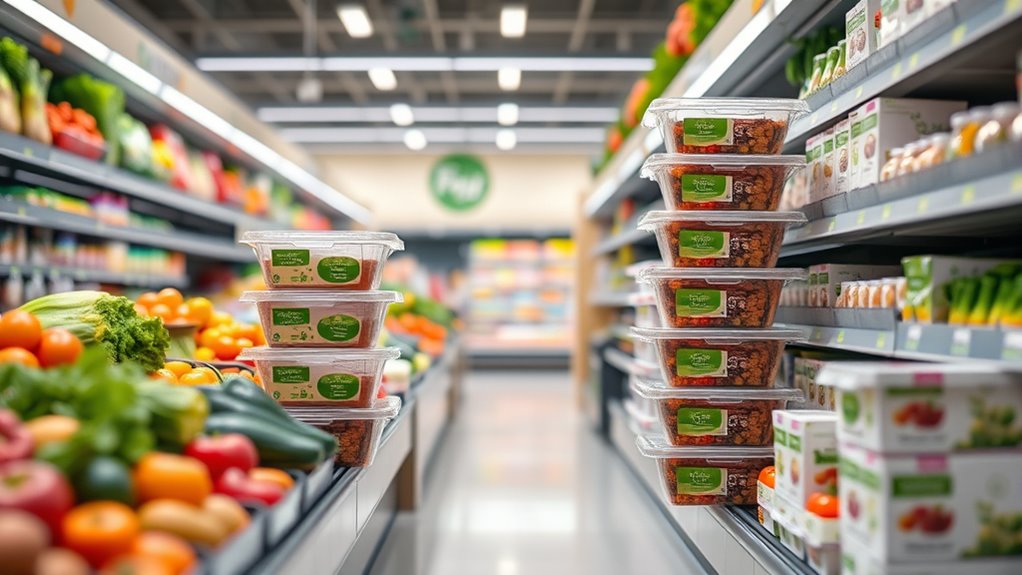
Reusable and modular packaging designs are transforming the way businesses approach sustainability by reducing waste and increasing efficiency. You’ll see more reusable containers and modular packaging that adapt to different products, cutting down on single-use plastics. These innovations allow you to reuse packaging multiple times or customize sizes for various items, minimizing environmental impact. By choosing modular packaging, companies can optimize storage and reduce transportation emissions. This shift empowers you to support eco-friendly brands committed to sustainability.
| Impact | Benefits | Future Potential |
|---|---|---|
| Less waste | Cost savings over time | Circular packaging systems |
| Reduced landfill burden | Enhanced brand loyalty | Fully recyclable designs |
| Lower carbon footprint | Increased consumer engagement | Zero-waste initiatives |
Smart Packaging With Embedded Eco-Friendly Sensors
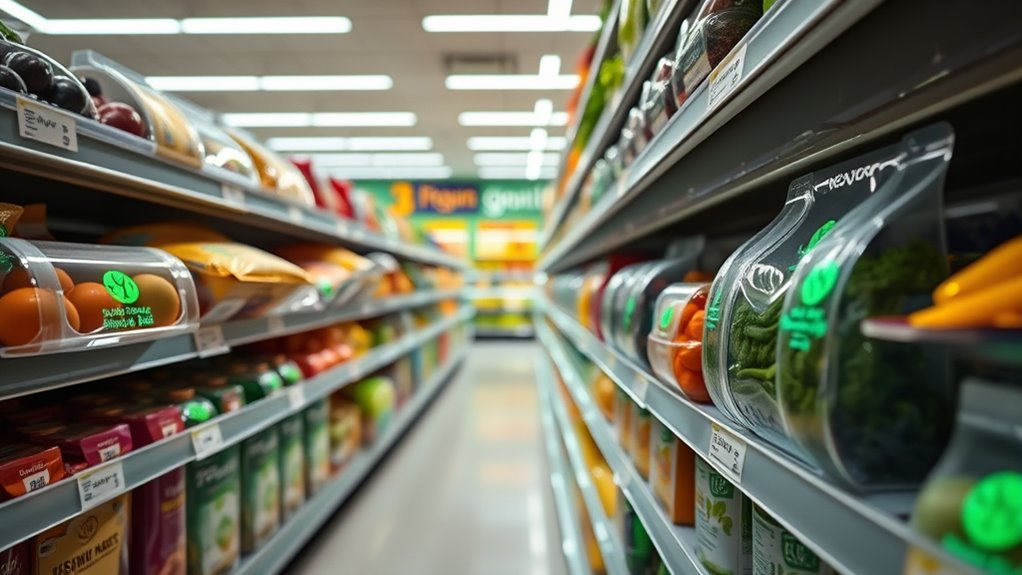
Smart packaging with embedded eco-friendly sensors is revolutionizing how you monitor and reduce environmental impact. These innovations use smart sensors to track freshness, temperature, and waste levels in real-time, helping you make informed decisions. Eco friendly indicators embedded within packaging alert you to spoilage or improper storage, minimizing food waste. This technology not only ensures product quality but also promotes sustainability by reducing unnecessary disposal.
- Detect spoilage early with smart sensors that trigger eco friendly indicators
- Optimize supply chain efficiency through real-time environmental data
- Reduce waste by receiving precise freshness updates directly on packaging
Compostable Wrappers and Films for Fresh Produce
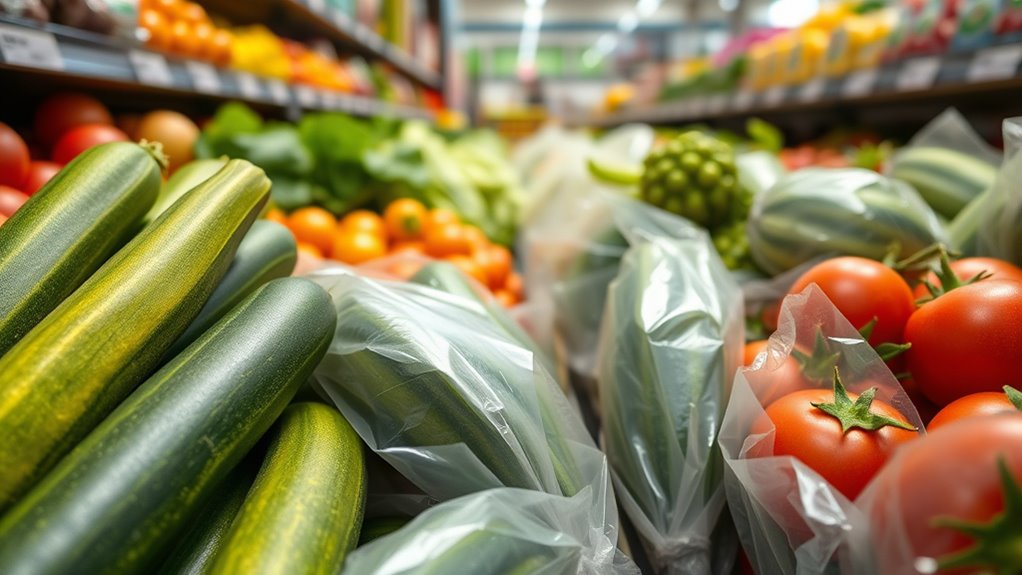
Compostable wrappers and films for fresh produce are transforming sustainable packaging by offering an eco-friendly alternative to traditional plastic. These innovations use recyclable textiles that break down naturally, reducing landfill waste. You’ll notice biodegradable labels on these wrappers, providing clear information without harming the environment. These compostable films maintain freshness and protect produce during transportation, all while supporting your commitment to sustainability. Their ability to decompose in composting conditions means less plastic pollution and a smaller carbon footprint. As grocery stores adopt these solutions, you’ll see more products wrapped in biodegradable films that align with your values. This shift not only helps preserve the planet but also encourages consumers and suppliers to embrace greener packaging options for the future.
Zero-Waste Packaging Initiatives and Circular Economy Models
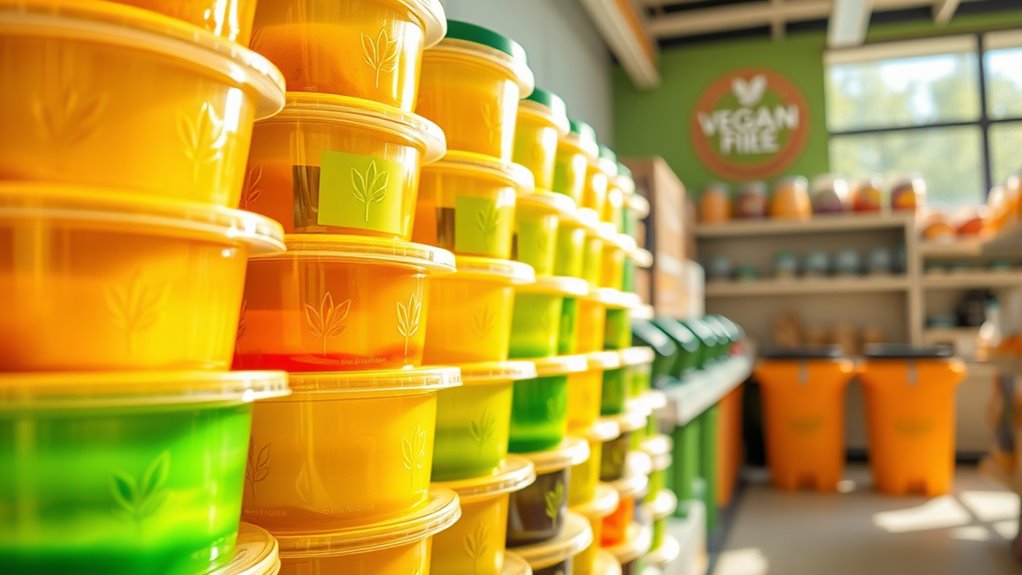
As the push for sustainability intensifies, zero-waste packaging initiatives and circular economy models are reshaping how products are designed and consumed. You’ll see companies adopting packaging that minimizes waste, encourages reuse, and integrates seamlessly into recycling programs. These models focus on creating closed-loop systems where packaging materials are continually repurposed, reducing environmental impact. To succeed, consumer education becomes essential, helping you understand proper disposal and reuse practices. Key strategies include:
Zero-waste packaging and circular models promote reuse, recycling, and consumer education for sustainable consumption.
- Implementing return and refill programs to extend packaging life
- Designing packaging with recyclable or biodegradable materials
- Promoting awareness campaigns to improve recycling habits
Frequently Asked Questions
Will Vegan Packaging Be as Durable as Traditional Options?
You might wonder if vegan packaging can match traditional durability. The good news is that advances in biodegradable plastics and plant-based coatings are closing that gap. These materials are engineered to be strong, resistant, and eco-friendly, so you won’t have to sacrifice durability for sustainability. As technology progresses, vegan packaging will likely become just as reliable, offering you eco-conscious options that stand up to everyday use.
How Will Edible Packaging Ensure Food Safety Standards?
Did you know that edible packaging could reduce plastic waste by up to 50%? You’ll see that biodegradable containers and edible coatings are designed to meet strict food safety standards. These innovations undergo rigorous testing to prevent contamination, ensuring they’re safe for consumption. By choosing edible packaging, you help protect the environment while maintaining food safety, making it a smart, sustainable choice for your grocery shopping.
Are Natural Dyes Environmentally Safer Than Synthetic Inks?
You’ll find that natural dyes, like eco friendly pigments and plant-based dyes, are generally safer for the environment than synthetic inks. They come from renewable resources, produce less pollution during manufacturing, and biodegrade more easily. By choosing natural dyes, you reduce chemical runoff and lower your carbon footprint. Overall, they’re a more sustainable option that helps protect ecosystems while still delivering vibrant colors.
Can Reusable Packaging Effectively Replace Single-Use Plastics?
Imagine a world where your choices create ripples of change. Reusable packaging can indeed replace single-use plastics if you choose biodegradable materials that break down naturally. By adopting composting methods, you help reduce waste and reliance on landfills. Your commitment to reusables fosters a sustainable cycle, proving that thoughtful reuse isn’t just a trend but a powerful step toward protecting our environment and making a lasting impact.
How Will Smart Packaging Protect Against Sensor Malfunctions?
You wonder how smart packaging can protect against sensor malfunctions. To guarantee sensor reliability, manufacturers will incorporate multiple layers of protection and real-time diagnostics into packaging sensors. This way, if a sensor malfunctions, the system detects it immediately, preventing false data or compromised freshness. You can trust that these innovations will make smart packaging more reliable, safeguarding your food quality and providing peace of mind during storage and transportation.
Conclusion
As you explore these 2025 vegan packaging innovations, it’s clear how your choices can shape a more sustainable future. From edible wraps to smart, compostable materials, each innovation aligns with a growing trend toward eco-conscious living—sometimes by coincidence, reminding you that small actions can lead to big change. Embrace these advancements and realize that what you buy today can help create a cleaner, greener world tomorrow.

